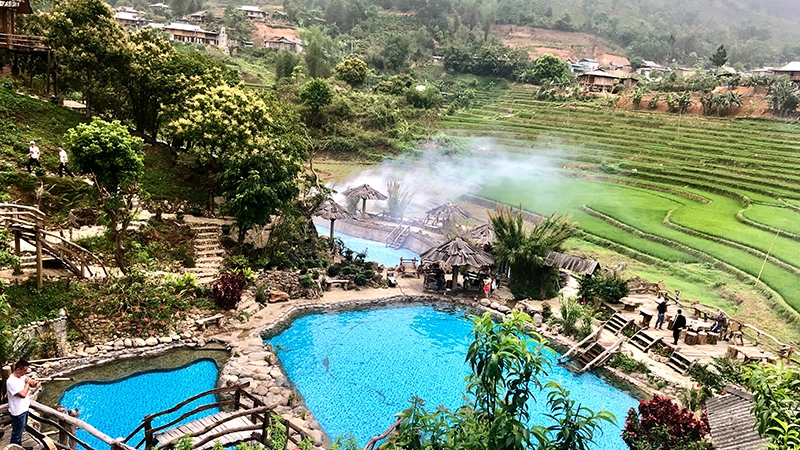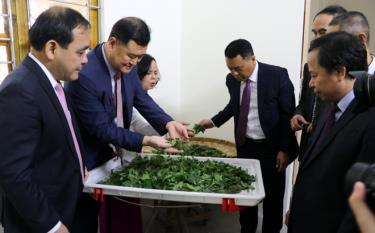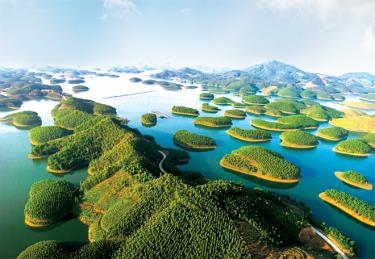In April, when the Ban (Bauhinia) flowers cover the northwestern mountains, the orange orchards are ripe and red across the hills, travellers are eager to explore new lands and destinations. About 100 kilometres from the centre of Yen Bai city, Tram Tau district is far, but the unspoilt natural landscapes, majestic mountains and picturesque terraced fields are key factors that draw tourists from across the country.
Cu Vai village, Ta Chi Nhu peak (Ha Ho commune), Hang Te Cho waterfall (Lang Nhi commune) are names many adventurers have heard and that make them want to put on their backpack.
Contributing to the map of Vietnam's well-known terraced fields, along with the famous terraced fields in locations such as Hoang Su Phi (Ha Giang province), Y Ty (Lao Cai), Mu Cang Chai (Yen Bai), the Tram Tau terraced fields has become a sought after name. In addition, Tram Tau hot springs are also an attractive destination.
After navigating some winding and dangerous roads - typical curves of the Northwestern mountains, passing through Nghia Lo town, about 2 kilometres from the center of Tram Tau district, the Tram Tau hot spring area is bedded in full green rice fields, between layers of mountains and clouds, surrounded by the peaceful and simple roofs of indigenous people.
Covering an area of 600 square metres, situated among the terraced fields, the Tram Tau hot spring area is a gentle highlight amongst the majestic mountains. The underground source circuit has created more attractions for Tram Tau, changing this place into an eco-tourist resort. Visitors to Tram Tau hot springs can immerse themselves in warm water with average temperatures ranging between 43 and 45 degrees Celsius, enjoy breathtaking landscapes and the cultural characteristics of the ethnic minority people here.
Although it is about to enter the early summer days, in Tram Tau, the feeling of spring is still here. The sounds of the birds and insects chirping, and the cool air makes everyone want to immerse themselves in the natural scenery, and thake in the four seasons of the year. Dawn rises to dispel the morning mist, gentle sunlight breaks through the floating clouds; and the cold winds of autumn. The scent of baked potatoes and sticky rice in the kitchen wafts in the chilly late afternoon air.
Located on the Yen Bai - Nghia Lo - Mu Cang Chai travel network, Tram Tau can be a stopover on a travel schedule, but also a suitable destination for a short trip. From Tram Tau, visitors can go to Mu Cang Chai to marvel at the rice fields, conquer the top of Ta Xua mountain to hunt for clouds, or explore fascinating places such as Phu Luong mountain, the top of Ta Chi Nhu mountain, with its pink flowers named chi pau covering the mountainsides.
Coming to Tram Tau, wandering in the villages, talking with the H'Mong and Thai people, visitors have a chance to learn and experience the cultural life of the local people, enjoy typical dishes such as five-colour sticky rice, black banh chung (square glutinous rice cake), bamboo shootw, spring moss, and stir-fried bees with bamboo shoots, black chicken, and drink Shan Tuyet tea in Phinh Ho.
Currently, Tram Tau still retains its pristine beauty all year round. In May and June, Tram Tau’s terraced fields enter their water-pouring season. In the harvest season, in September and October, when the terraced fields turn yellow with ripe rice, Tram Tau shines again with the beauty of labour. Women in traditional clothes hide in the golden rice fields.
In recent years, Tram Tau’s tourism has developed. Many homestays, accommodation services, and dining services managed by indigenous people have expanded, contributing to completing the chain of activities to serve tourists. In addition to experiential mountaineering and community tourism, ecotourism and relaxation in Tram Tau is considered a promising model to be taken advantage of to make the best use of its potential and rich cultural features.
NDO






